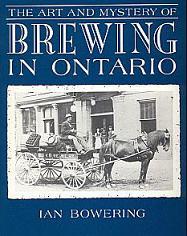 While I stand by my statement:
While I stand by my statement:
“…brewing history can be a tool or route to understanding for some but is ultimately unimportant if you do not need to tap into it…”
… I have to admit that I do like dabbling in it – as long as I stay within the reach of my own capabilities. I especially like dabbling in it care of a stack of bedside books when I am, like today, on the third day of the treatment for a blip of pneumonia. And good thing, too, as it’s not like the weeks of cough medications leading to this stage have left me longing for a tart gueuze. But, while we are at it, would it kill big pharmacy to make a expectorant that tastes like an imperial stout?
Anyway, one of the books recently added to the pile is 1988’s The Art And Mystery Of Brewing in Ontario by Ian Bowering. We suffer in Canada from a lack of understanding of ourselves and no where more than here in Ontario. Atlantic Canadians, Quebeckers and Western Canadians all are rightly proud of themselves even if it is largely based on how they have each been screwed in their own special way by that place to stand, place to grow, Ontar-i-ar-i-ar-i-o.
Bowering’s book helps with Ontario’s blandness. It sits in an important place with others on brewing in Canada and does one thing particularly well. It lists the breweries by town. Simple thing but it shows that brewing advanced across the province as the population advanced westerly from the early 1790s or before in eastern Kingston to the late 1890s in Rat Portage, over 2,000 km to the NW. It also shows that brewing was going on at a far larger scale, unexpected industrialization with far greater distribution earlier on than some might suggest. Brains Brewery in rural 1834 was producing 100 barrels a week. Lager was being made in Kitchener well before 1850 and even wee Huether Crystal Springs in little Neustadt delivered in a 70 km radius a few year later.
Information will advance and it is evident more information has come to light when we compare the listings for Kingston and compare them to the brand new book The Breweries of Kingston and The St. Lawrence Valley by Steve Gates which follows a similar structure. But as one wag recently stated:
…that there are others out there who will identify errata and offer corrections is something which will ultimately contribute to the further development and maturation of this particular field of study.
I might add that it is the only way it will further develop and mature. And not only through peer review and correction but building on the shoulders of others who have gone before. So Gates cites Bowering, Sneath cites Bowering, Mr. B cites Bowering, Pashley cites Mr. B and Sneath. It’s the way things work, the way we build the collective body of knowledge – if, that is, we are actually interested in presenting what actually was.
